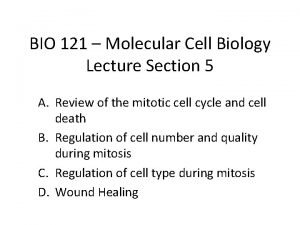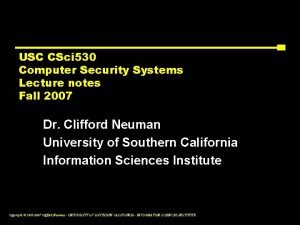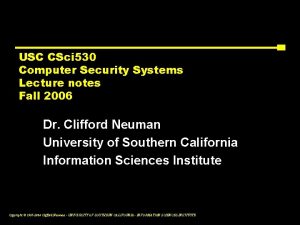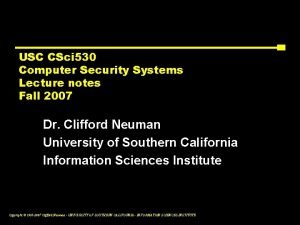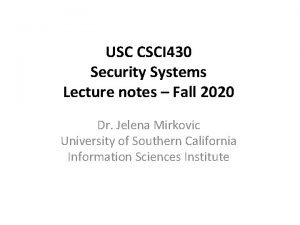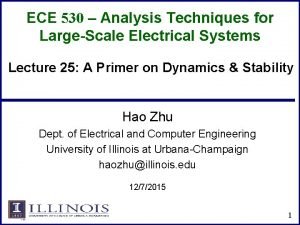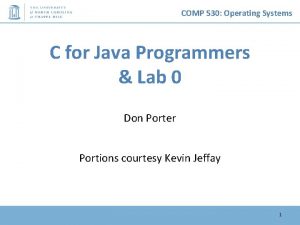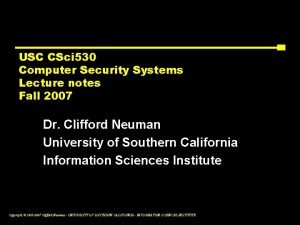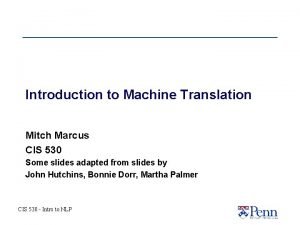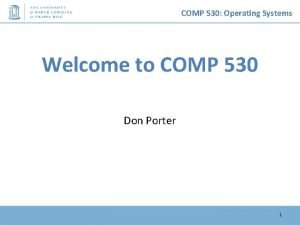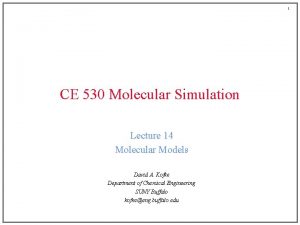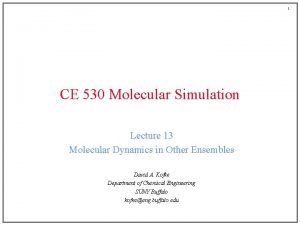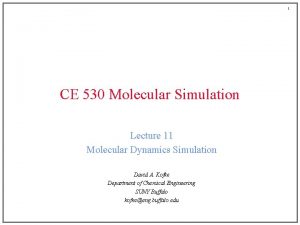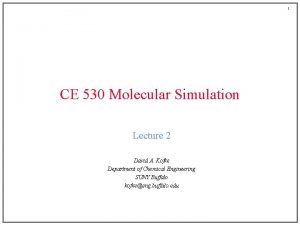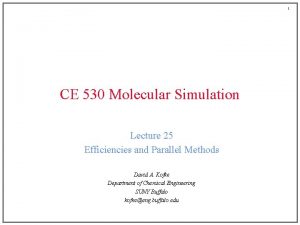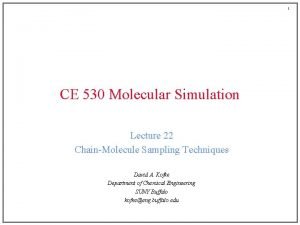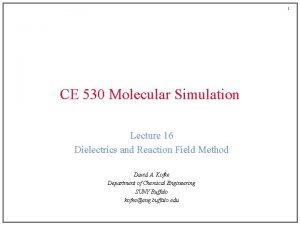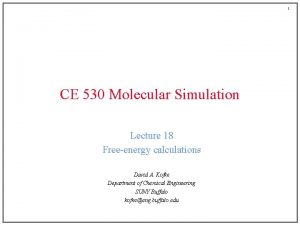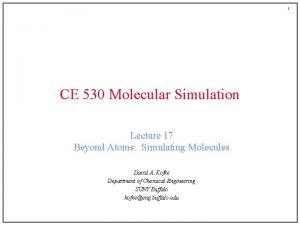1 CE 530 Molecular Simulation Lecture 7 David
















- Slides: 16

1 CE 530 Molecular Simulation Lecture 7 David A. Kofke Department of Chemical Engineering SUNY Buffalo kofke@eng. buffalo. edu

2 Monte Carlo Simulation ¡ Gives properties via ensemble averaging • No time integration • Cannot measure dynamical properties ¡ Employs stochastic methods to generate a (large) sample of members of an ensemble • “random numbers” guide the selection of new samples ¡ Permits great flexibility • members of ensemble can be generated according to any convenient probability distribution… • …and any given probability distribution can be sampled in many ways • strategies developed to optimize quality of results ergodicity — better sampling of all relevant regions of configuration space variance minimization — better precision of results ¡ MC “simulation” is the evaluation of statistical-mechanics integrals still too hard!

3 One-Dimensional Integrals ¡ Methodical approaches • rectangle rule, trapezoid rule, Simpson’s rule Sum areas of shapes approximating shape of curve Evaluating the general integral n uniformly separated points ¡ Quadrature formula

4 Monte Carlo Integration ¡ Stochastic approach ¡ Same quadrature formula, different selection of points n points selected from uniform distribution p(x) ¡ Click here for an applet demonstrating MC integration

5 Random Number Generation ¡ Random number generators • subroutines that provide a new random deviate with each call • basic generators give value on (0, 1) with uniform probability • uses a deterministic algorithm (of course) usually involves multiplication and truncation of leading bits of a number linear congruential sequence ¡ Returns set of numbers that meet many statistical measures of randomness • histogram is uniform • no systematic correlation of deviates Plot of successive deviates (Xn, Xn+1) no idea what next value will be from knowledge of present value (without knowing generation algorithm) but eventually, the series must end up repeating ¡ Some famous failures • be careful to use a good quality generator Not so random!

6 Errors in Random vs. Methodical Sampling ¡ Comparison of errors for example (Simpson’s rule) • methodical approach • Monte Carlo integration ¡ MC error vanishes much more slowly for increasing n ¡ For one-dimensional integrals, MC offers no advantage ¡ This conclusion changes as the dimension d of the integral increases • methodical approach • MC integration independent of dimension! ¡ MC “wins” at about d = 4 d=2 36 points, 361/2 = 6 in each row

7 Shape of High-Dimensional Regions ¡ Two (and higher) dimensional shapes can be complex ¡ How to construct and weight points in a grid that covers the region R? Example: mean-square distance from origin

8 Shape of High-Dimensional Regions ¡ Two (and higher) dimensional shapes can be complex ¡ How to construct and weight points in a grid that covers the region R? • hard to formulate a methodical algorithm in a complex boundary • usually do not have analytic expression for position of boundary • complexity of shape can increase unimaginably as dimension of integral grows ¡ We need to deal with 100+ dimensional integrals Example: mean-square distance from origin

9 Integrate Over a Simple Shape? 1. ¡ Modify integrand to cast integral into a simple shaped region • define a function indicating if inside or outside R ¡ Difficult problems remain • grid must be fine enough to resolve shape • many points lie outside region of interest • too many quadrature points for our highdimensional integrals (see applet again) ¡ Click here for an applet demonstrating 2 D quadrature

10 Integrate Over a Simple Shape? 2. ¡ Statistical-mechanics integrals typically have significant contributions from miniscule regions of the integration space • • contributions come only when no spheres overlap • e. g. , 100 spheres at freezing the fraction is 10 -260 ¡ Evaluation of integral is possible only if restricted to region important to integral • must contend with complex shape of region • MC methods highly suited to “importance sampling”

11 Importance Sampling ¡ Put more quadrature points in regions where integral receives its greatest contributions ¡ Return to 1 -dimensional example ¡ Most contribution from region near x = 1 ¡ Choose quadrature points not uniformly, but according to distribution p(x) • linear form is one possibility ¡ How to revise the integral to remove the bias?

12 The Importance-Sampled Integral ¡ Consider a rectangle-rule quadrature with unevenly spaced abscissas ¡ Spacing between points • reciprocal of local number of points per unit length … Greater p more points smaller spacing ¡ Importance-sampled rectangle rule • Same formula for MC sampling choose x points according to p

13 Generating Nonuniform Random Deviates ¡ Probability theory says. . . • . . . given a probability distribution u(z) • if x is a function x(z), • then the distribution of p(x) obeys ¡ Prescription for p(x) • solve this equation for x(z) • generate z from the uniform random generator • compute x(z) ¡ Example • • we want on x = (0, 1) a and c from “boundary conditions” then so x = z 1/2 taking square root of uniform deviate gives linearly distributed values ¡ Generating p(x) requires knowledge of

14 Choosing a Good Weighting Function ¡ MC importance-sampling quadrature formula ¡ Do not want p(x) to be too much smaller or too much larger than f(x) • too small leads to significant contribution from poorly sampled region • too large means that too much sampling is done in region that is not (now) contributing much

Variance in Importance Sampling Integration ¡ Choose p to minimize variance in average ¡ Smallest variance in average corresponds to p(x) = c f(x) • • not a viable choice the constant here is selected to normalize p if we can normalize p we can evaluate this is equivalent to solving the desired integral of f(x) ¡ Click here for an applet demonstrating importance sampling 15

Summary ¡ Monte Carlo methods use stochastic process to answer a nonstochastic question • generate a random sample from an ensemble • compute properties as ensemble average • permits more flexibility to design sampling algorithm ¡ Monte Carlo integration • good for high-dimensional integrals better error properties better suited for integrating in complex shape ¡ Importance Sampling • focuses selection of points to region contributing most to integral • selecting of weighting function is important • choosing perfect weight function is same as solving integral ¡ Next up: • Markov processes: generating points in a complex region 16
 01:640:244 lecture notes - lecture 15: plat, idah, farad
01:640:244 lecture notes - lecture 15: plat, idah, farad Cell and molecular biology lectures
Cell and molecular biology lectures Enteroendocrine cell
Enteroendocrine cell Diapedesis
Diapedesis What is a covalent bond simple definition
What is a covalent bond simple definition Ionic covalent metallic
Ionic covalent metallic Zinc oxide + nitric acid → zinc nitrate + water
Zinc oxide + nitric acid → zinc nitrate + water Csci 530
Csci 530 Csci 530 security systems
Csci 530 security systems Csci 530 security systems
Csci 530 security systems Csci 430 usc
Csci 430 usc Ece 530
Ece 530 Comp 530
Comp 530 Bioc 530
Bioc 530 Csci 530 usc
Csci 530 usc Chinese to english translation
Chinese to english translation Comp 530
Comp 530



